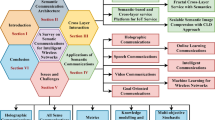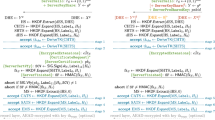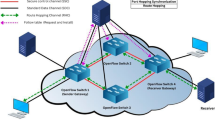Abstract
Transport protocols provide reliable, end-to-end communication between a source and a destination in a network. The Transmission Control Protocol (TCP) uses backward error correction, where the destination explicitly returns feedback to the source. Forward error correction (FEC) can also be used for transport; here the source includes enough redundancy in the encoding symbols to allow the destination to decode the message. In this paper, we compare the performance of two transport schemes, TCP and LT, a scheme based on rateless FEC codes, in a wireless ad hoc network when topology-transparent scheduling is used for channel access. These schedules are derived from cover-free families, a type of combinatorial design. They provide a mechanism to guarantee collision-free communication between any two nodes provided that each of the N nodes of the network has at most a specified number D of active (transmitting) neighbours. We find that LT outperforms TCP in more strenuous network conditions.
Similar content being viewed by others
References
Bloemer J, Kalfane M, Karpinski M, Karp R, Luby M, Zuckerman D (1995) An XOR-based erasure-resilient coding scheme. Technical report TR-95-048, ICSI, August 1995
Chlamtac I, Faragó A (1994) Making transmission schedules immune to topology changes in multi-hop packet radio networks. IEEE/ACM Trans Netw 2(1):23–29
Chlamtac I, Pinter S (1987) Distributed node organization algorithm for channel access in a multi-hop packet radio network. IEEE Trans Comput 36(6):728–737
Chu W, Colbourn CJ, Syrotiuk VR (2004) Topology transparent scheduling, synchronization and maximum delay. In: Proceedings of the 18th international parallel and distributed processing symposium (IPDPS’04), April 2004, pp 223–228
Chu W, Colbourn CJ, Syrotiuk VR (2006a) Slot synchronized topology-transparent scheduling for sensor networks. Comput Commun 29(4):421–428
Chu W, Colbourn CJ, Syrotiuk VR (2006b) The effects of synchronization on topology-transparent scheduling. Wirel Netw 12:681–690
Colbourn CJ, Syrotiuk VR (2005) Cover-free families and topology-transparency. Bayreuther Math Schr 73:86–106
Colbourn CJ, Dinitz JH, Stinson DR (1999) Applications of combinatorial designs to communications, cryptography, and networking. In: Lamb JD, Preece DA (eds) Surveys in Combinatorics. Cambridge University Press, Cambridge, pp 37–100
Colbourn CJ, Syrotiuk VR, Ling ACH (2003) Steiner systems for topology-transparent access control in MANETs. In: Proceedings of the second international conference on ad hoc networks and wireless (Ad hoc Now’03), October 2003, pp 247–258
Colbourn CJ, Ling ACH, Syrotiuk VR (2004) Cover-free families and topology-transparent scheduling for MANETs. Des Codes Cryptogr 32(1–3):65–96
Digital Fountain (2004) Breakthrough reliable transport technology for data and live streaming delivery over imperfect networks. Technology licensing white paper. Available at http://www.digitalfountain.com
Du DZ, Hwang FK (2000) Combinatorial group testing and its applications. 2nd edn. World Scientific, Singapore
Dukes PJ, Colbourn CJ, Syrotiuk VR (2006) Topology-transparent schedules for energy limited ad hoc networks. In: Proceedings of the IEEE international workshop on foundations and algorithms for wireless networking (FAWN’06), March 2006, pp 85–90
Dukes PJ, Colbourn CJ, Syrotiuk VR (2007) Directed complete bipartite graph decompositions: indirect constructions. Discret Math (to appear)
D’yachkov A, Vilenkin P, Macula A, Torney D (2002) Families of finite sets in which no intersection of ℓ sets is covered by the union of s others. J Comb Theory Ser A 99:195–218
Erdös P, Frankl P, Füredi Z (1985) Families of finite sets in which no set is covered by the union of r others. Israel J Math 51:79–89
Hedayat AS, Sloane NJA, Stufken J (1999) Orthogonal arrays, theory and applications. Springer, Berlin
IEEE Standards Committee (1996) Wireless LAN medium access control (MAC) and physical layer (PHY) specifications. In: IEEE 802.11 standard. IEEE, New York, ISBN 1-55937-935-9
Jacobson V (1988) Congestion avoidance and control. In: Proceedings SIGCOMM, August 1988, pp 314–329
Johnson D, Maltz D (1996) Dynamic source routing in ad hoc wireless networks. In: Imelinsky T, Korth H (eds) Mobile computing. Kluwer Academic, Dordrecht, pp 153–181
Ju J-H, Li VOK (1998) An optimal topology-transparent scheduling method in multihop packet radio networks. IEEE/ACM Trans Netw 6(3):298–306
Luby MG (2002) LT codes. In: Proceedings of the 43rd symposium on foundations of computer science (FOCS’02), November 2002, pp 271–280
Postel JB (1981) RFC 793: Transmission control protocol. ftp://ds.internic.net/rfc/rfc793.txt. September 1981
Rizzo L (1997) Effective erasure codes for reliable computer communication protocols. Comput Commun Rev 27(2):24–36
Ruszinkó M (1994) On the upper bound of the size of the r-cover-free families. J Comb Theory Ser A 66:302–310
Stinson DR, Wei R, Zhu L (2000) Some new bounds for cover-free families. J Comb Theory Ser A 90:224–234
Syrotiuk VR, Colbourn CJ, Ling ACH (2003) Topology-transparent scheduling for MANETs using orthogonal arrays. In: Proceedings of the DIALM-POMC joint workshop on foundations of mobile computing, September 2003, pp 43–49
The Virtual InterNetwork Testbed (VINT) Project (1995) The network simulator—ns-2. http://www.isi.edu/nsnam/vint/index.html
Zhu C, Corson S (1998) A five-phase reservation protocol (FPRP) for mobile ad hoc networks. In: Proceedings of 17th annual joint conference of the IEEE computer and communication societies (Infocom’98), March–April 1998, pp 315–321
Author information
Authors and Affiliations
Corresponding author
Additional information
To Frank Hwang on the occasion of his sixty-fifth birthday.
Rights and permissions
About this article
Cite this article
Syrotiuk, V.R., Zhang, Z. & Colbourn, C.J. Transport schemes for topology-transparent scheduling. J Comb Optim 14, 229–248 (2007). https://doi.org/10.1007/s10878-007-9058-4
Published:
Issue Date:
DOI: https://doi.org/10.1007/s10878-007-9058-4




